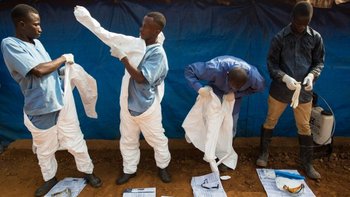The current Ebola crisis will end one day and we will have to think about its significance for humanitarian aid. There are many questions which cannot be considered at this stage when the emergency is rife but which will come to haunt the humanitarian system: Is the Ebola crisis a turning point? What does it reveal for the societies where it has run out of control and for the humanitarian aid which is struggling to match the needs it has generated? In what sense can a neglected disease, which flares up so regularly since 1976 continue being presented as a ‘new’ emergency? What are the consequences of taking a ‘security’ approach to a disease? Perhaps, crucially, has Ebola brought a new perspective on danger and risk for the humanitarian system? From a historian’s perspective, is it a great leap backwards?
Historians have long studied epidemics as disasters and the panic that they generated, from cholera to exotic diseases such as yellow fever which hit Northern America and Europe in the nineteenth century. Then, humanitarians and medical staff faced extreme personal risks while the medicine and relief they offered delivered little more than remedial care. These parameters have returned albeit mitigated by processes and equipment to the humanitarian world.
The management of Ebola victims is reliant on considerable precautionary processes requiring careful training but therapeutically, at least for the time being, the medical practices hark back to the earlier days of humanitarian medicine. Unlike their Victorian counterparts, today most medical workers are unused to dispense treatments which impact so little on clinical outcomes. Furthermore humanitarian organisations have new employers’ responsibilities and duties of care to contend with which necessarily slows deployment. The whole notion of risk assessment takes a new dimension in the same way that the ethics of medical testing are challenged by Ebola’s extremely high mortality rate for patients or untrained or unprotected health workers.
It brings to the fore ancient social responses such as quarantine which, throughout history, have shown to fail whenever an epidemic reached large proportions or escaped the containment of enclosed means of circulation (such as ships). This failure was sometimes heroic and the epidemiologists know the tale of Eyam, the village near Sheffield that nearly entirely died for England in 1665 during its self-enforced strict quarantine. Historians of medicine have shown that it suffered unnecessarily and that its death rate from the plague was twice what it might have been without quarantine.
Ebola is not the Black Plague or Spanish Influenza (which killed about 50 millions worldwide between 1918 and 1920) and it is not either a terrorist threat. The idea that Ebola has become almost primarily a ‘global security threat’, says a lot more about our militarised world view than about the disease. The management of Ebola involves the kind of kit the military have long used in their preparation for biological warfare, thus a military response seems almost logical. Yet, not all killer diseases are susceptible to become the focus of biosecurity planning or random panic purchase of protective clothing. Polio which was the focus of much attention last year did not provoke this kind of response. Tuberculosis or Malaria kill so many more and indeed will kill on the sly in the midst of an Ebola epidemic, but fail the other criteria met by Ebola: its ‘weaponisable’ status inherited from the Cold War.
If this disease calls for the biological warfare logistics and deployment capability of the military it also reopens long closed medical pages. Up to the first half of the twentieth century, humanitarians were going to danger, much like today, but often found that this danger was biological rather than the result of political violence or warfare. The ICRC and MSF have been busy denouncing the new dangers associated with offering assistance in unconventional wars. Today Ebola is reshaping the nature of the danger humanitarians will have to confront and the precautions they have to take to safeguard their own health. Much like new multidrug resistant TB and various forms of antibiotic resistant bacteria, biohazards are re-shaping the range of risks humanitarian workers may face.
You may be able to negotiate in politics but you can’t do so with viruses, hence one can only erect barriers protecting the individual. At a society’s level these barriers may only be a dream or would prove socially difficult or dangerous. Ebola may be contained soon but coming out of Ebola will not mean the end of biosecurity concerns for the humanitarian world. The nature of the danger has changed and with this realisation come new potentially self-defeating practices.
With the dreams of quarantine favoured by politicians one has to engage with their potential consequences and induced restrictions to freedom or indeed humanitarian work. The insurers and actuaries involved with the humanitarian sector and its responses will review their algorithms and premiums, meanwhile humanitarians may have to consider afresh the ‘bunkers’ they have, up to now, deployed against political risks alone.
The security paradigm which now dominates the public and politicised responses to Ebola is likely to endure. From being a tool for a more powerful response deploying military resources and budgets, it is to be feared that militarised responses and the recourse to security-based frames of analysis may change durably how humanitarians reflect on danger and the world.
